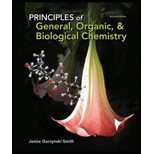
Concept explainers
(a)
Interpretation:
Skeleton structure of DHA fatty acid has to be drawn:
Concept Introduction:
Fatty acid is an important component of lipid that consists of a carboxyl group
Fatty acid consists of hydrophobic and hydrophilic parts. The nonpolar part of the chain that consists of carbon and hydrogen atoms and is water repellant called hydrophobic part and the polar part that is attracted to water is called hydrophilic part. The hydrophobic part is larger than that of hydrophilic part.
(b)
Interpretation:
The
Concept Introduction:
Refer to part (a).
Want to see the full answer?
Check out a sample textbook solution
Chapter 15 Solutions
Principles of General Organic & Biological Chemistry
- Draw the structures of (a) 6-methyl-3-heptanol and (b) trans-2-methylcyclohexanolarrow_forwardGive the IUPAC name.arrow_forwardWhen the conjugate acid of aniline, C6H5NH3+, reacts with the acetate ion, the following reaction takes place: C6H5NH3+(aq)+CH3COO(aq)C6H5NH2(aq)+CH3COOH(aq) If Kafor C6H5NH3+ is 1.35105 and Kafor CH3COOH is 1.86105 , what is K for the reaction?arrow_forward
- The action of heating one mole of water (containing a trace of acid catalyst) on one mole of compound Y produces one mole of CH,COOH and one mole of CH, CH,NH, The structure of Y is: Select one: O CHCNCCH, CH,CH,NHCH,CH, OH CH CHNHCH,CH, O CHCH,CNHCH; O CH;CH NHÖCH;arrow_forwardDraw compounds that contain the following: (a) A primary alcohol (c) A secondary thiol (c) An isopropyl group (b) A tertiary nitrile (d) A quaternary carbonarrow_forwardWrite the products of the following acid-base reactions: (a) CH3OH + H2SO4 ² ? (b) CH3OH + NANH2 2 ? (c) CH3NH3+ Cl- + NaOH ?arrow_forward
- Give the IUPAC name and the line structure formula of the following compound: HỌC CH CH₂ (a) H₂C=CHCHCCH3 (b) CH₂CH₂CH=CCH₂CH₂ CH3 [ CH₂ CH₂ (c) CH₂CH=CHCHCH=CHCHCH,arrow_forward(a) Classify the carbon atoms in each compound as 1°, 2°, 3°, or 4°. (b) Classify the hydrogen atoms in each compound as 1°, 2°, or 3°.arrow_forward(a) Enter the IUPAC name for this alcohol: CH,CH,CHCH, ОН Classify it as a primary, secondary, or tertiary alcohol: (b) Enter the IUPAC name for this alcohol: CH,CHCH,CH,CHOH CH, ČH, Classify it as a primary, secondary, or tertiary alcohol:arrow_forward
- Arrange the following substances in order of increasing boiling point: CH:CH2OH, HOCH:CH:OH, CH:CH:CI, and ClICH:CH:OH O CH; CH2OH < HOCH:CH:OH < CH,CH:CI < CICH;CH2OH O CH, CH;CI < CH,CH,OH < CICH;CH;OH < HOCH,CH;OH CH,CH2OH < CICH,CH,OH < CH,CH;CI < HOCH;CH2OH O CH3 CH2OH < CH3CH2CI < HOCH2CH2OH < CICH:CH2OHarrow_forwardWhich of the following molecules (1) (2) CH,0-ČCH,CH, CH,CH,CH (3) О—С—Он (4) OH CH,CHCH,CH, (5) CH,-NH would: neutralize NaOH neutralize HCI yields an alcohol and an organic acid when hydrolyzed is easily oxidized to an acid would be classifed as aromatic could be oxidized to give a ketonearrow_forwardDraw the products formed when propan-2-ol [(CH3)2CHOH], the main ingredient in rubbing alcohol, is treated with each acid or base: (a) NaH (b) H2SO4 (c) Li+−N[CH(CH3)2]2 (d) CH3CO2H.arrow_forward
 Organic ChemistryChemistryISBN:9781305580350Author:William H. Brown, Brent L. Iverson, Eric Anslyn, Christopher S. FootePublisher:Cengage Learning
Organic ChemistryChemistryISBN:9781305580350Author:William H. Brown, Brent L. Iverson, Eric Anslyn, Christopher S. FootePublisher:Cengage Learning Chemistry: Principles and ReactionsChemistryISBN:9781305079373Author:William L. Masterton, Cecile N. HurleyPublisher:Cengage Learning
Chemistry: Principles and ReactionsChemistryISBN:9781305079373Author:William L. Masterton, Cecile N. HurleyPublisher:Cengage Learning

